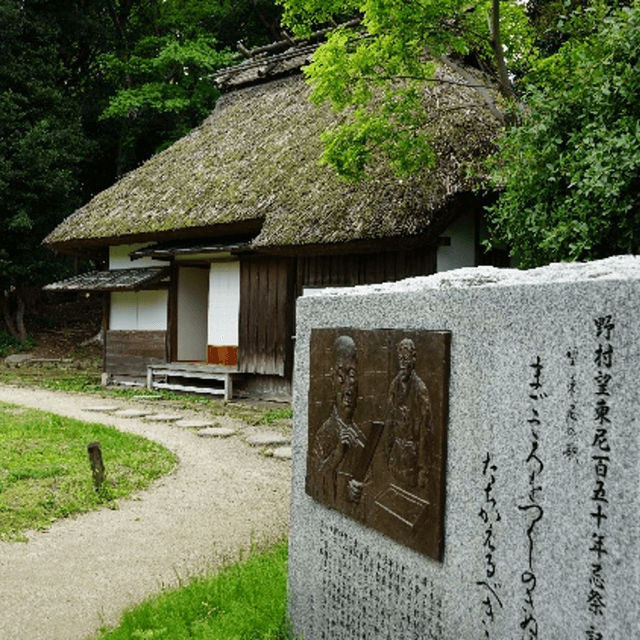
幕末の歌人として、また維新の先覚者の一人として知られる野村望東尼(のむらぼうとうに)の閑居地。
望東尼は本名を「モト」といい、文化(ぶんか)3(1806)年9月6日、福岡藩士浦野重右衛門勝幸(うらのじゅうえもんかつゆき)(300石)の三女として、福岡城の近傍南谷の御厩後(おうまやのうしろ)(現在の中央区六本松三丁目付近)に生まれました。文政(ぶんせい)12(1829)年、野村新三郎貞貫(のむらしんざぶろうさだつら)(413石)の後妻となり、弘化(こうか)2(1845)年貞貫とともにこの地に隠棲、大隈言道(おおくまことみち)について和歌を学びました。
54歳の時に夫を亡くしたことで剃髪しますが、この頃から勤王の志を抱き、平野国臣(ひらのくにおみ)、中村円太(なかむらえんた)、長州の高杉晋作(たかすぎしんさく)等を庇護しました。しかし、佐幕派による勤王派の粛清におよび、慶応(けいおう)元(1865)年10月に望東尼も捕えられ、姫島(ひめしま)(糸島市)に流されます。11カ月の幽閉の後、高杉晋作に救い出されて馬関(ばかん)(山口県下関市)に移り、さらに三田尻(みたじり)(山口県防府市)に移り、慶応3年(1867)11月、62歳で没しました。
当初の草庵は腐朽してしまいましたが、明治42(1909)年に組織された向陵会により復元され、その後望東会に引き継がれて再建、現在は福岡市が管理しています。草庵のほかに望東尼に関する資料を展示する管理棟があり、市指定の史跡として整備されています。
【開館時間(草庵・管理棟)】9:00~17:00(入場は16:30まで)
【入館料】無料
【休館日】12月29日~1月3日
A hermitage associated with Nomura Botōni (Motoni), known both as a poet of the late Edo period and as a forerunner of the Restoration.
Her real name was “Moto,” born on September 6, 1806 (Bunka 3), the third daughter of Urano Jūemon Katsuyuki, a Fukuoka Domain retainer with a stipend of land worth 300 koku, in Uma-ya-no-ushiro, Minamitani, near Fukuoka Castle (around today’s Ropponmatsu 3-chōme, Chūō Ward). In 1829 (Bunsei 12) she became the second wife of Nomura Shinzaburō Sadatsura (stipend worth 413 koku), and in 1845 (Kōka 2) she and Sadatsura retired to this area, where she studied waka poetry under Ōkuma Kotomichi.
At age 54, after losing her husband, she took the tonsure (shaved her head). Around this time she embraced loyalist (Imperial) ideals and gave protection to figures such as Hirano Kuniomi, Nakamura Enta, and Takasugi Shinsaku of Chōshū. However, when pro-shogunate forces began purging loyalists, Botōni herself was arrested in October 1865 (Keiō 1) and exiled to Himeshima (Itoshima City). After eleven months of confinement she was rescued by Takasugi Shinsaku and moved to Bakan (present-day Shimonoseki, Yamaguchi Prefecture), and then to Mitajiri (now Hōfu, Yamaguchi Prefecture), where she died in November 1867 (Keiō 3) at the age of 62.
The original thatched hut fell into ruin, but it was restored by the Kōryōkai, organized in 1909 (Meiji 42), and later rebuilt under its successor, the Botōkai; today the site is managed by Fukuoka City. In addition to the hermitage, there is an administration building that exhibits materials related to Botōni, and the site is maintained as a City-designated historic site.
Opening hours (Hermitage & Administration Building): 9:00 a.m. to 5:00 p.m. (last entry: 4:30 p.m.)
Admission: Free
Closed: December 29–January 3
スタンプを獲得すると、限定の壁紙をゲットできます。
スタンプを集めてね / Collect a stamp
限定の壁紙を獲得しました。
以下のボタンから壁紙を表示し、長押しで”写真”に保存してください。
